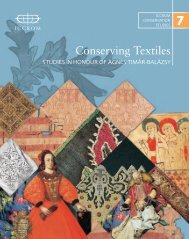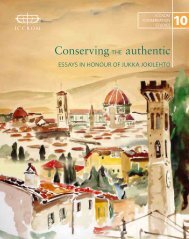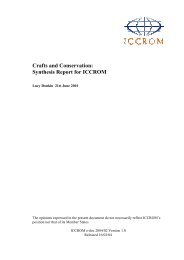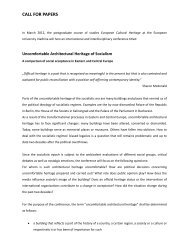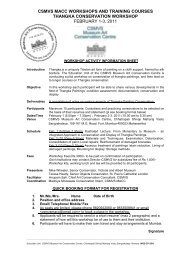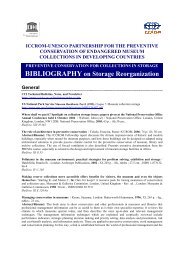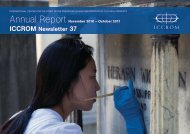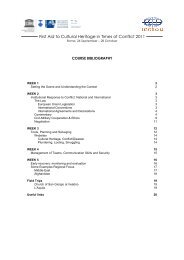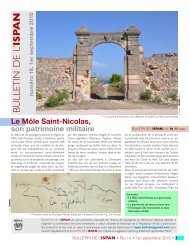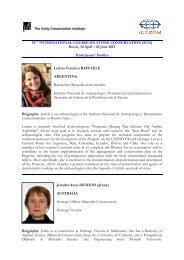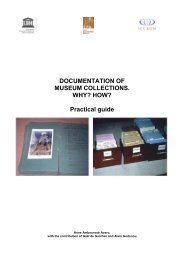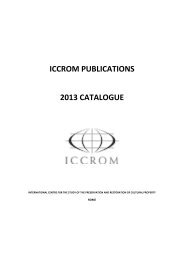part 1 - Iccrom
part 1 - Iccrom
part 1 - Iccrom
Create successful ePaper yourself
Turn your PDF publications into a flip-book with our unique Google optimized e-Paper software.
Assessing the cultural significance of world heritage cities: Zanzibar as a<br />
case study<br />
Yvonne Vroomen, 1 Dave ten Hoope, 1 Bastiaan Moor, 1 Ana Pereira Roders, 2 Loes Veldpaus·3 & Bernard<br />
Colenbrander 4<br />
Abstract<br />
This paper focuses on the World Heritage property ‘the Stone Town of Zanzibar’, located on the island<br />
Zanzibar, in the United Republic of Tanzania. The Stone Town is a case study that is <strong>part</strong> of a larger research<br />
program called: ‘Outstanding Universal Value, World Heritage cities and Sustainability: Surveying the relationship<br />
between the Outstanding Universal Value assessment practices and the sustainable development<br />
of World Heritage cities’ lead by the Eindhoven University of Technology, the Netherlands; and UNESCO<br />
World Heritage Centre, France.<br />
The aim of the research is to help stakeholders involved in policy, management, and development of the<br />
Stone Town determine the adequacy of their current strategies towards sustainable development of the Stone<br />
Town, without damaging its Outstanding Universal Value (OUV) as defined by the World Heritage Centre.<br />
By assessing the OUV as stated in the official documents as well as the authenticity and integrity of the attributes<br />
representing the OUV apparent in the core zone, a comparison can be made.<br />
The policy documents (the Decision Text, Recommendation File and the Nomination File) will be assessed<br />
by means of revealing the dimensions of the cultural significance of the Stone Town in terms of cultural<br />
values. To complement this, the cultural values represented by the attributes of the Stone Town as well as its<br />
authenticity and integrity will be surveyed. This leads to a better insight into the (in-) consistencies between<br />
the ascribed cultural values represented in the policy documents on the one hand and the physical attributes<br />
on the other.<br />
Keywords: Stone Town, Zanzibar, World Heritage, UNESCO, sustainable development<br />
1<br />
Eindhoven University of Technology, the Netherlands.<br />
2<br />
Eindhoven University of Technology, the Netherlands. a.r.pereira@bwk.tue.nl<br />
3<br />
Eindhoven University of Technology, the Netherlands. l.veldpaus@tue.nl<br />
4<br />
Eindhoven University of Technology, the Netherlands. b.j.f.colenbrander@tue.nl<br />
Introduction<br />
This paper focuses on the World Heritage (WH)<br />
property ‘the Stone Town of Zanzibar’, located on<br />
the island Zanzibar, United Republic of Tanzania.<br />
The case study of the Stone Town is <strong>part</strong> of a larger<br />
research program called: ‘Outstanding Universal<br />
Value, World Heritage cities and Sustainability: Surveying<br />
the relationship between the Outstanding<br />
Universal Value assessment practices and the sustainable<br />
development of World Heritage cities’ lead<br />
by the Eindhoven University of Technology, the<br />
Netherlands; and UNESCO World Heritage Centre,<br />
France (Pereira Roders and Van Oers, 2010). It is an<br />
innovative, collaborative and comparative research<br />
program that aims to make a significant contribution<br />
to both research and practice on World Heritage<br />
management and sustainable development (ibid.).<br />
v v v<br />
The main question of this case study is: how can<br />
the Stone Town develop sustainably, without damaging<br />
its Outstanding Universal Value (OUV)? This<br />
paper, however, will cover only <strong>part</strong> of this question.<br />
The research presented in this paper consists of<br />
a systematic analysis of the following policy documents<br />
containing information on the cultural significance<br />
of the Stone Town: the Decision Text (DT),<br />
the Recommendation File (RF) and the Nomination<br />
File (NF). This in order to find out in what way the<br />
original justification for inscription – as adopted by<br />
the World Heritage Committee (WHC) under criteria<br />
(ii) 1 , (iii) 2 and (vi) 3 (ICOMOS, 1999) is to be found<br />
echoed along the subsequent policy documents and<br />
in the physical attributes that make up the Stone<br />
Town.<br />
Vroomen, Y.; ten Hoope, D.; Moor, B.; Pereira Roders, A.; Veldpaus, L.·& B. Colenbrander. 2012. Assessing the cultural significance<br />
of World Heritage cities: Zanzibar as a case study. In Zancheti, S. M. & K. Similä, eds. Measuring heritage conservation performance, pp.<br />
67-74. Rome, ICCROM.<br />
67



